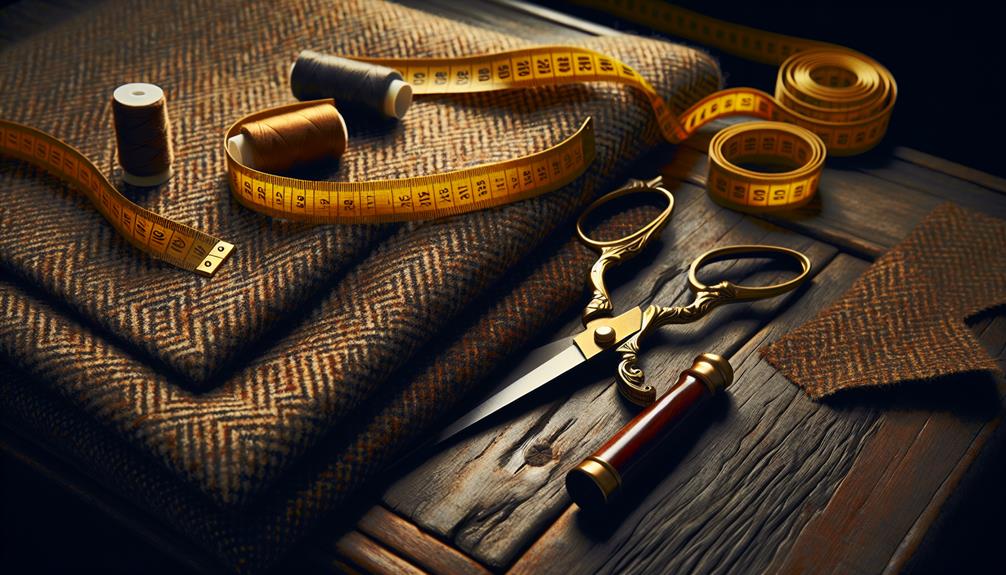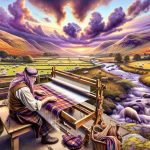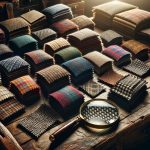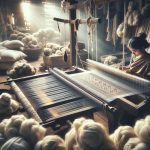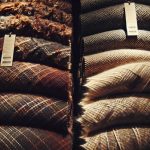So, let's talk about tweed. It's often seen as a luxury, right? With its roots deeply embedded in British aristocracy, it's not just any fabric; it's got a whole legacy. The effort that goes into making tweed is something else—high-quality materials, detailed weaving, the works. But here's the thing, while it screams sophistication and has a price tag to match, is it really all about luxury, or is there more to the story? I'm curious to explore why it's held in such high regard and whether it's as indispensable as it's portrayed. What do you think?
Table of Contents
Key Takeaways
- Tweed is considered a luxury due to its meticulous craftsmanship and premium materials.
- Its historical association with British aristocracy adds to its prestige and luxury status.
- The complex weaving techniques and high thread count ensure durability and exclusivity.
- Tweed often carries a high price tag, reflecting its luxurious reputation and skilled labor involved.
- Celebrities and high-fashion designers frequently use tweed, enhancing its desirability and elite appeal.
The Historical Roots of Tweed
Why don't we explore how tweed, originally a practical fabric for Scottish farmers, became synonymous with luxury and style?
Diving into the tweed origins, it began as a rugged material woven to withstand the harsh Scottish weather. The name 'tweed' itself is thought to come from a misreading of 'twill,' the fabric's weaving style, or from the River Tweed in Scotland.
The transformation from a farmer's utility to a symbol of aristocratic associations wasn't overnight. When members of the British aristocracy began hunting and vacationing in the Scottish Highlands in the 19th century, they adopted tweed. They needed attire that blended with the landscape and weather but also met their refined tastes. Tweed was perfect.
This aristocratic endorsement changed tweed's image. It wasn't just practical; it was now prestigious. Aristocrats wore bespoke tweed outfits, showcasing intricate patterns and colors that soon became fashion statements. This shift highlighted tweed's versatility and durability, but with a luxurious twist.
Thus, tweed's journey from humble beginnings to high-end circles isn't just about fabric. It's a reflection of how style evolves and how what was once necessary becomes a marker of sophistication and class.
Tweed's Manufacturing Process
As we look at what makes tweed potentially a luxury item, I'll start by explaining how it's made.
First, the selection of raw materials is essential, as only the finest fibers guarantee a high-quality fabric.
Next, I'll talk about the specific weaving techniques that give tweed its unique texture and durability.
Raw Materials Selection
The selection of raw materials for tweed production primarily involves selecting high-quality wool from specific breeds of sheep. I'm particularly keen on the fiber characteristics and sourcing ethics, as these factors define the luxury and sustainability of the final product. Here's a breakdown of the key elements I consider:
| Factor | Importance |
|---|---|
| Breed of Sheep | Critical for determining the texture and durability of the tweed. |
| Fiber Quality | Must be high; affects the feel and appearance. |
| Sourcing Location | Preferably local to reduce carbon footprint and support local economies. |
| Ethical Practices | Ensures the wool is gathered humanely and responsibly. |
Choosing the right materials isn't just about aesthetics; it's about respecting the environment and ensuring quality craftsmanship.
Weaving Techniques Used
Moving on to the manufacturing process, tweed's distinctive texture largely comes from unique weaving techniques. Different loom types play an important role here. Traditional tweed is often crafted on shuttle looms, which allow for tighter weaving and a higher thread count. This results in not just durability but also that signature dense feel.
It's the thread count that truly defines the quality. A higher thread count means finer threads and a more intricate weave, contributing to both the texture and the pattern complexity of tweed. I've found that understanding these elements deeply enhances one's appreciation of tweed as more than just fabric, but as a craft that's been perfected over generations. It's fascinating how much detail goes into every thread!
Finishing and Quality Control
After weaving, tweed goes through thorough finishing and quality control to guarantee its luxury standard. First off, the fabric's washed to soften it and enhance the texture. It's important, especially for comfort. Then, it's all about checking color consistency. I make sure the dye has taken evenly across the fabric because nothing screams ‘luxury' like perfect, uniform color.
Now, let's talk seam durability. When I'm crafting a tweed jacket or trousers, those seams need to hold. I pull, stretch, and stress-test to make sure they'll stand up to wear and tear. It's non-negotiable because who wants their high-end tweed splitting at the seams? Definitely not me, and I'm sure not my clients either.
Iconic Tweed Fashion Pieces
When you think about tweed, Chanel's classic tweed jacket instantly comes to mind, doesn't it?
It's not just about jackets though; Harris Tweed also makes some killer outerwear that's both stylish and durable.
And don't forget, tweed isn't stuck in the past; it's made its way into modern accessories, keeping the fabric fresh and relevant.
Chanel's Classic Tweed Jacket
Chanel's classic tweed jacket, an iconic piece of fashion, revolutionized women's wardrobes with its elegant and timeless design. It's not just about the tweed; it's the jacket embellishments that elevate it to luxury status. Think delicate braiding, subtle sequins, and those instantly recognizable interlocking Cs. Celebrities have long endorsed this staple, from Grace Kelly to Rihanna, cementing its status in high fashion.
Each wears it uniquely, yet it continues to exude a sense of class and sophistication. It's clear why this jacket remains a staple in the fashion industry. It's versatile, transcending seasons and trends, making it a smart investment for those looking to refine their style with a piece that's both classic and chic.
Harris Tweed Outerwear Staples
Harris Tweed isn't just fabric; it's a tradition woven into every piece of outerwear that bears its name. Iconic jackets and coats made from this material aren't only stylish but incredibly functional. They're known for their exceptional weather resistance, making them ideal for misty, unpredictable climates.
I've found the durability of these pieces unmatched, and their unique charm lies in the rich color variations — from deep moss greens to earthy browns and soft grays. Each hue is inspired by the natural landscape of the Scottish Hebrides.
Owning a Harris Tweed jacket means you're carrying a piece of Scottish heritage, tailored to withstand both the elements and the changing trends of fashion.
Tweed in Modern Accessories
While Harris Tweed remains a staple in outerwear, it's also made a big splash in modern accessories, from chic handbags to stylish hats. The allure of tweed in accessories isn't just about tradition; it's also about innovation and personal expression. Tweed customization allows enthusiasts to own unique pieces that truly reflect their style.
Here's a quick look at how tweed is revolutionizing accessories:
| Accessory Type | Example | Benefit of Tweed |
|---|---|---|
| Handbags | Tweed Clutch | Durable yet elegant |
| Hats | Tweed Cap | Classic look with a modern twist |
| Wallets | Tweed Bi-fold | Stylish and practical |
| Shoes | Tweed Loafers | Unique texture adds flair |
| Watches | Tweed Watch Straps | Subtle sophistication |
Accessory innovation in the tweed market is booming, giving rise to pieces that blend heritage with contemporary fashion.
Tweed in Contemporary Design
Tweed has made a bold comeback in contemporary design, blending traditional charm with modern aesthetics. As a fabric, it's evolved beyond its classic, countryside vibe to something you'd spot in hip, urban boutiques and sleek design studios. This resurgence isn't just about nostalgia; it's about pushing boundaries. Designers are playing with tweed textures in ways that are fresh and unexpected—think tweed incorporated in avant-garde fashion pieces or sleek, contemporary furniture.
In this wave of tweed innovation, the fabric's tactile richness is being explored more creatively. We're seeing lighter, more malleable tweeds that drape beautifully in high-fashion garments, contrasting sharply with the stiff, heavy tweeds of yore. This transformation allows tweed to be used in more versatile applications, from stylish office wear to chic, casual looks.
What's exciting is how these innovations are received. There's a real appreciation for how tweed can be both a nod to craftsmanship and a forward-looking material. Whether it's in the cut of a jacket or the upholstery of a trendy couch, tweed retains an essence of luxury while staying relevant in modern design narratives. It's clear that tweed isn't just surviving; it's thriving.
The Role of Tweed in Sustainability
When examining the sustainability of tweed, it's important to take into account how its production affects the environment. The traditional methods used to produce tweed, especially in regions like the Scottish Isles, often involve natural fibers and eco-friendly practices. However, it isn't all green and clean. The dyeing processes can be resource-intensive and pollutant if not managed correctly. That's where modern recycling practices come into play.
Incorporating recycled fibers into tweed manufacturing can greatly reduce the environmental footprint. I've seen mills that are starting to adopt these practices, aiming to blend tradition with innovation. This shift not only preserves the environment but also resonates with consumer awareness. Nowadays, buyers are more informed and tend to favor products that are both luxurious and environmentally responsible.
Comparing Tweed With Other Fabrics
Comparing tweed with other fabrics highlights its unique blend of durability and style. When we explore fabric durability, tweed stands out with its tightly woven wool construction, offering excellent resistance to wear and tear. This makes it a trusty option compared to lighter materials like cotton or silk, which mightn't endure the same rough handling.
In a comfort comparison, tweed is often perceived as less cozy than softer fabrics like cashmere or fleece. Its texture can be a bit rougher, which some might find less appealing for everyday wear. However, this same characteristic contributes to its structured, sophisticated look that's hard to replicate with more pliable textiles.
Another major point is tweed's adaptability in various weather conditions. Unlike linen, which is exclusively a summer fabric, or velvet, which is mainly worn in colder months, tweed provides warmth without compromising breathability, making it versatile across seasons.
Ultimately, tweed's allure isn't just about its practical benefits. Its historical roots and the skilled craftsmanship required to produce it add an element of luxury and exclusivity. While other fabrics might excel in either comfort or style, tweed uniquely maintains a balance of both, securing its place in the high-end fabric spectrum.
Tweed's Popularity Among Celebrities
Celebrities often choose tweed for its timeless appeal and sophisticated look. This fabric has become synonymous with elegance and class, making it a staple for those in the limelight. You'll notice tweed making appearances at high-profile red carpet events, where style is scrutinized and every choice is a statement. It's not just about warmth or comfort; it's about projecting an image of refined taste.
Celebrity endorsements greatly enhance tweed's profile. When a well-known figure wears tweed, it instantly gains more visibility and desirability. This phenomenon isn't just about following trends. Celebrities influence fashion by setting trends, and their adoption of tweed reaffirms its status as a luxurious and desirable material. The impact is profound; once a celebrity is seen in tweed, it often becomes a sought-after item among their fans and style followers.
Moreover, designers are keen to dress celebrities in tweed for public appearances and magazine shoots, knowing that this exposure is invaluable. The association with popular cultural icons elevates tweed's prestige, making it more than just a fabric—it's a fashion statement embraced by those at the pinnacle of public attention.
The Cost of Tweed Apparel
Tweed apparel often comes with a hefty price tag due to its luxurious reputation and meticulous craftsmanship. If you're eyeing a tweed jacket or a bespoke suit, you're not just paying for fabric; you're investing in the art of tailoring and the heritage of a fabric that has been around for ages. Let's explore why that price tag might be steeper than you'd expect and whether tweed's cost truly aligns with its value.
Firstly, the process of creating tweed involves complex weaving techniques, often done on traditional looms. This not only adds to the uniqueness of each piece but also to the cost. Additionally, high-quality tweed is typically made from premium wool, which itself isn't cheap. When you factor in skilled labor, especially for tailored items, it's no wonder the prices can skyrocket.
Now, about tweed affordability: it's tricky. While retail pricing for off-the-rack tweed items might seem more accessible, bespoke or designer tweed can create a significant dent in your wallet. It's about finding that balance between cost and desire for a timeless piece. So, if you're contemplating adding tweed to your wardrobe, consider it an investment in quality and style rather than a mere clothing purchase.
Cultural Significance of Tweed
Tweed's not just a fabric; it's steeped in history, having roots that trace back to the Scottish islands where it was first woven. Nowadays, it's making a comeback in modern fashion, showing up in everything from casual wear to high-end designer lines.
Let's look at how tweed has moved from traditional to trendy, and what that says about its place in culture today.
Tweed's Historical Roots
Delving into its past, tweed's cultural significance stems from its deep roots in the rural traditions of Scotland and Ireland. Originating as a practical fabric for shepherds battling the harsh climates, its Scottish origins are undeniable.
Initially handwoven by locals using wool from their own sheep, tweed was a demonstration of self-sufficiency and local craftsmanship. Over time, its durability caught the attention of the aristocracy. The fabric became synonymous with aristocratic associations, especially when members of the upper class adopted tweed for hunting and outdoor pursuits in the rugged Scottish landscapes.
This shift not only elevated its status but also intertwined tweed's identity with notions of prestige and tradition, an enduring legacy that continues to influence its perception today.
Modern Tweed Trends
Shifting into the contemporary scene, tweed has seamlessly woven its way into modern fashion trends, retaining its cultural cachet. Designers are now reimagining tweed for the 21st century, integrating it into both high-fashion and practical tweed sportswear. They're leveraging advanced tweed technology to enhance fabric durability and comfort, making it suitable for everyday wear. This isn't just about aesthetics; it's about functionality too.
Tweed's unique texture and rich history continue to appeal to those who value both tradition and innovation. It's fascinating to see how this material has evolved yet still symbolizes a blend of craftsmanship and heritage. Whether it's on the runway or the streets, tweed remains a symbol of sophisticated, enduring style.
Future Trends in Tweed Fashion
Looking ahead, tweed is set to redefine modern fashion with innovative textures and eco-friendly practices. The rise of tweed technology, particularly digital tweed, is fascinating. It's all about using high-tech methods to create patterns and designs that were once unthinkable. We're moving beyond traditional limits, and I'm here for it!
To give you a clearer picture, here's how I see these trends evolving:
| Trend | Description |
|---|---|
| Smart Tweeds | Fabrics that adjust to temperature changes |
| Recycled Fibers | Tweed made from 100% recycled materials |
| Biodegradable Tweeds | Designs that decompose naturally |
| 3D Printed Patterns | Complex designs made possible through 3D technology |
| Digital Design Integration | Use of AI to create unique tweed patterns |
These advancements are not just about looking good. They're about making smart, sustainable choices that impact our planet positively. I'm especially excited about the potential of biodegradable tweeds. Imagine wearing a gorgeous blazer that, at the end of its life, can simply return to the earth. It's innovative, it's responsible, and it's the future I want to be part of.
Frequently Asked Questions
How Do You Properly Care for and Clean Tweed Garments?
I gently brush my tweed before storing it flat. For deeper cleans, I always opt for professional dry cleaning. This method preserves the fabric's integrity, ensuring my tweed garments stay in prime condition.
Can Tweed Be Worn in Summer or Is It Too Warm?
I've found that wearing lightweight tweed in summer works if you style it right. Opt for breathable weaves and lighter colors to keep cool while maintaining that classic, sophisticated look even in heat.
Are There Hypoallergenic Options Available for Tweed Fabric?
Yes, there are hypoallergenic tweed alternatives available that consider allergy issues. I've found some brands use organic fibers or treatments that reduce allergens, making tweed more accessible for those with sensitivities.
What Are the Best Color Combinations When Styling Tweed?
I've found that pairing earth tones with tweed textures works best. Modern accessories like sleek watches or minimalist bags complement it well, enhancing the overall sophistication without overpowering the fabric's classic charm.
How Does Tweed React to Long-Term Exposure to Sunlight?
Tweed's sunlight resistance isn't the best; it tends to fade when exposed long-term. I've noticed significant color fading in my tweed jackets that have spent too much time in bright, direct sunlight.
- Is Tweed More Expensive Than Wool? - April 24, 2024
- Is Tweed Fabric Itchy? - April 24, 2024
- How Durable Is Tweed? - April 24, 2024

